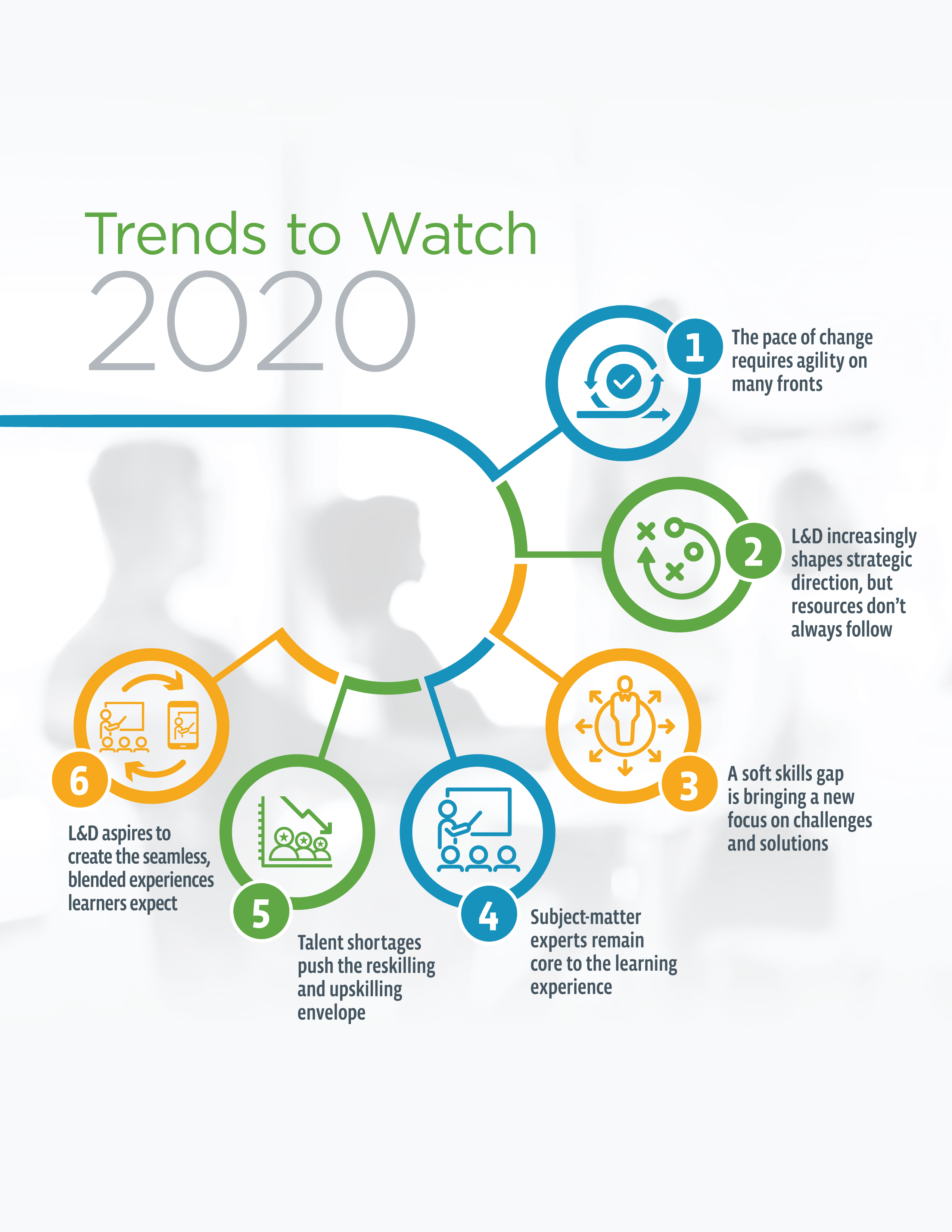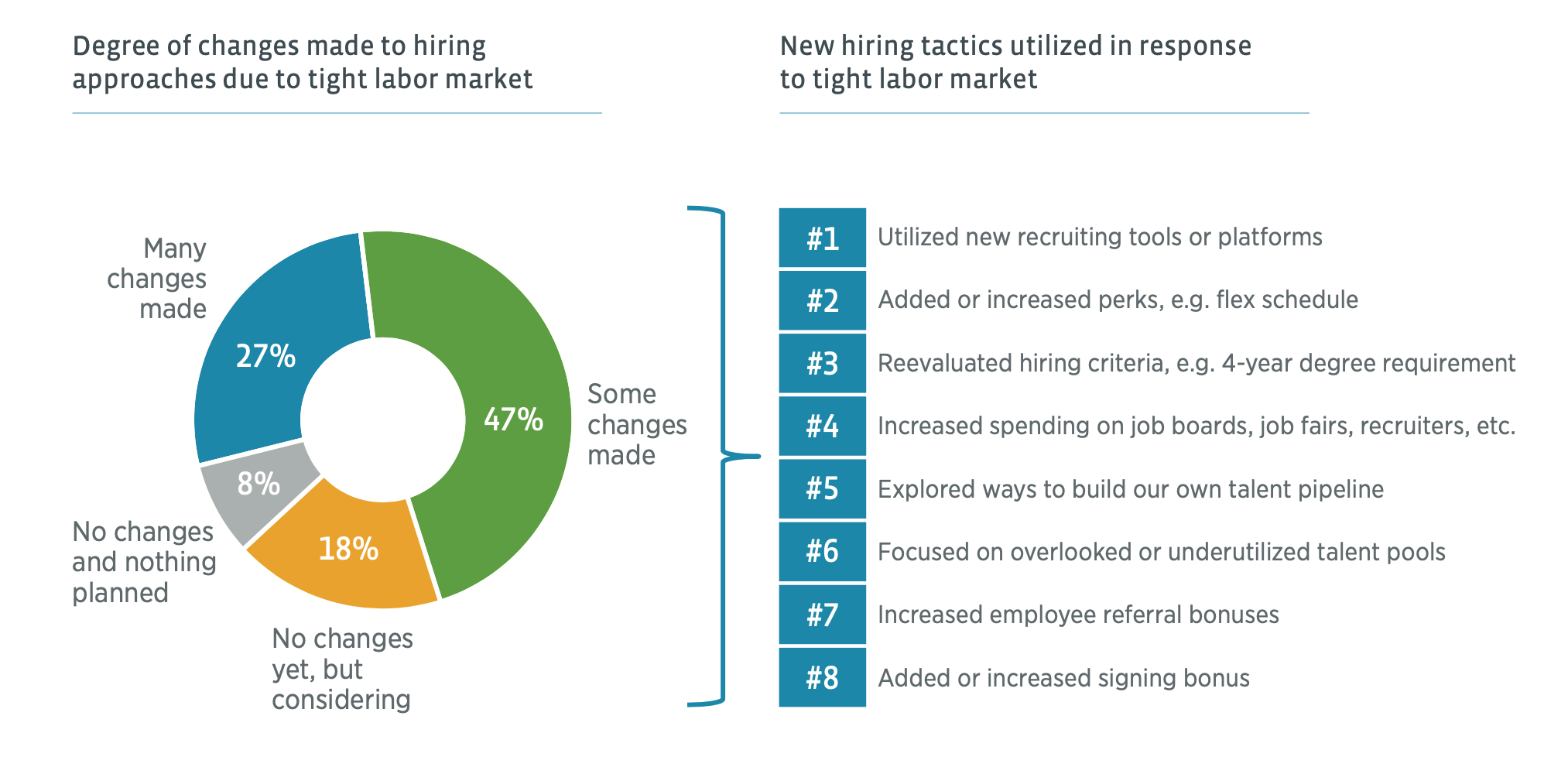Introduction
Evolving technologies, demographics and digital business models are changing the workplace at a faster pace than ever before. Meanwhile, available technologies — AI, people analytics, AR/VR, everything-as-a-service and more — promise to reshape the way learning is delivered and consumed. Learning and development (L&D) professionals — and the employers that rely on them for a future-ready workforce — are grappling to understand which innovations really matter.
What is the result of these forces and their responses by L&D professionals? CompTIA’s Workforce and Learning Trends 2020 finds that the training industry is mixing a new blend of familiar learning and certification methods with some technological twists. Think of this as the “New Traditional” training model that seeks out scalable tech-savvy improvements to L&D but relies on tried-and-true methods that remain essential to the learner experience.
For example, L&D leaders are often excited about technology that extends their ability to personalize instruction and communication. But some are more lukewarm on the innovative tech that enables mass distribution of learning content, which may reflect their personal experience or lack of exposure to successful, data-backed engagements.
New Traditional training models are also concerned with blending old and new subject matter. On one hand, domain-specific knowledge is critically important in subjects like cybersecurity, cloud computing and emerging technologies. On the other hand, L&D professionals are increasingly sensitive to the importance of “soft skills.” (More on that highly ambiguous term later.)
To develop the Workforce and Learning Trends 2020 report, CompTIA a) surveyed 400 HR and learning and development professionals to learn how technology and related macro-level workforce developments are reshaping L&D programs; b) spoke with experts in technology workforce development, certifications and education to identify the top trends on the horizon; and c) scanned the most authoritative publications on training trends from other organizations.
An outlook on an expansive topic like workforce learning and development must contain numerous nuances, caveats and exceptions. Pockets of early adopters may provide a glimpse of where the market is headed, or they may hype trends that will never make it past the niche use stage. The analysis in this report attempts to balance that dynamic.
The report presents six major findings and a section on what we didn’t find — prospective trends where signals are still mixed and the jury is still out on their mainstream potential.

The Pace of Change Requires Agility On Many Fronts
Rapid-fire technological innovations make talent development highly unpredictable, so agility in L&D is essential. Many L&D and HR leaders think their organizations aren’t keeping up. Nearly half (45%) of people from large organizations in the CompTIA survey rated a lack of agility as their top concern.
To make L&D programs more agile, organizations cannot afford to view training as a one-time event, says Stephanie Morgan, director of education and edtech labs at CompTIA. “The skills you train an employee for today are not the skills they’re going to need in five years.”
Steve Mallard, a master teacher at Tennessee College of Applied Technology, agrees. “Technology is coming out quicker than you can get people trained,” he says. “You have to be very dynamic in the classroom.”
L&D providers need to be dynamic in their approach, changing their focus from training for a specific skill at a point in time to helping employees upskill and reskill constantly. Agility requires broadening the tools in use and the skills taught, and fully embracing the “always learning” mindset.
Broader tool sets: Distributed learning
More corporations are shifting away from a centralized L&D system — increasingly referred to as a human capital management (HCM) system — to subscription-based, specialized and on-demand programs purchased by individual departments.
According to a survey of the workforce education technology marketplace from LearnLaunch Institute, an edtech accelerator in Boston, corporations are loosening control of “legacy monolithic Learning & Development systems” so that individual departments can provide more contextualized training. Cost-effective SaaS edtech allows control of training to spread through an organization and also allows smaller businesses to access it.
Broader skill sets: Adjacency learning
Previously siloed jobs are bleeding into each other, meaning employees need broader skill sets and are seeking out learning in multiple areas.
A 2019 technology skills report from SkillSoft, a corporate learning course publisher, found that the command-and-control structure in L&D is diminishing. As a result, learners are using edtech to access learning for adjacent skills.12
A 2018 CompTIA survey on the multi-generational workforce corroborates this point: Younger workers (Gen Y and Z) rank cross-training and contextual training near the top of their training wish list.

L&D Increasingly Shapes Strategic Direction, But Resources Don’t Always Follow
R&D is maturing as a field and becoming more professionalized. Most L&D leaders believe they can contribute to the strategic direction of their organizations. Some, but not all, feel their organizations are open to that strategic contribution. A significant minority feel a lack of support from the C-suite and frontline managers.
The good news is that when HR leaders were asked if L&D is treated or viewed as a strategic priority in their organization rather than an operational cost center, the great majority said “about in the middle” or better.
The bad news is that it depends on who is answering the question. Senior HR staff were more likely to say L&D was a mostly strategic priority than their junior colleagues, 35% to 22%. Junior HR staff were five times as likely as senior HR staff to say L&D is an operational cost center, 10% to 2%. However, a lack of leadership buy-in was not the leading reason cited for uneven support for L&D. Instead, the reason most commonly given was insufficient staff resources (41%).
See full report for more detailed analysis on workforce and learning trends to watch for 2020.
Download the full report PDF
Read more about IT Workforce.

 Download Full PDF
Download Full PDF